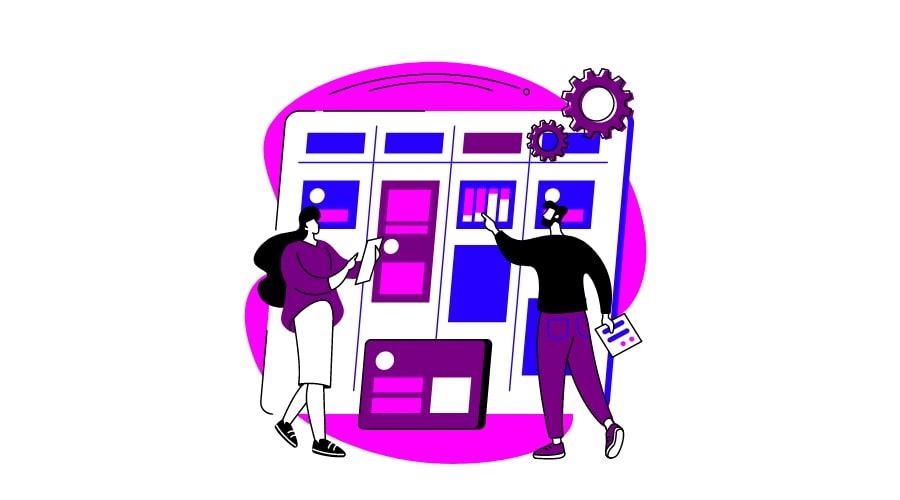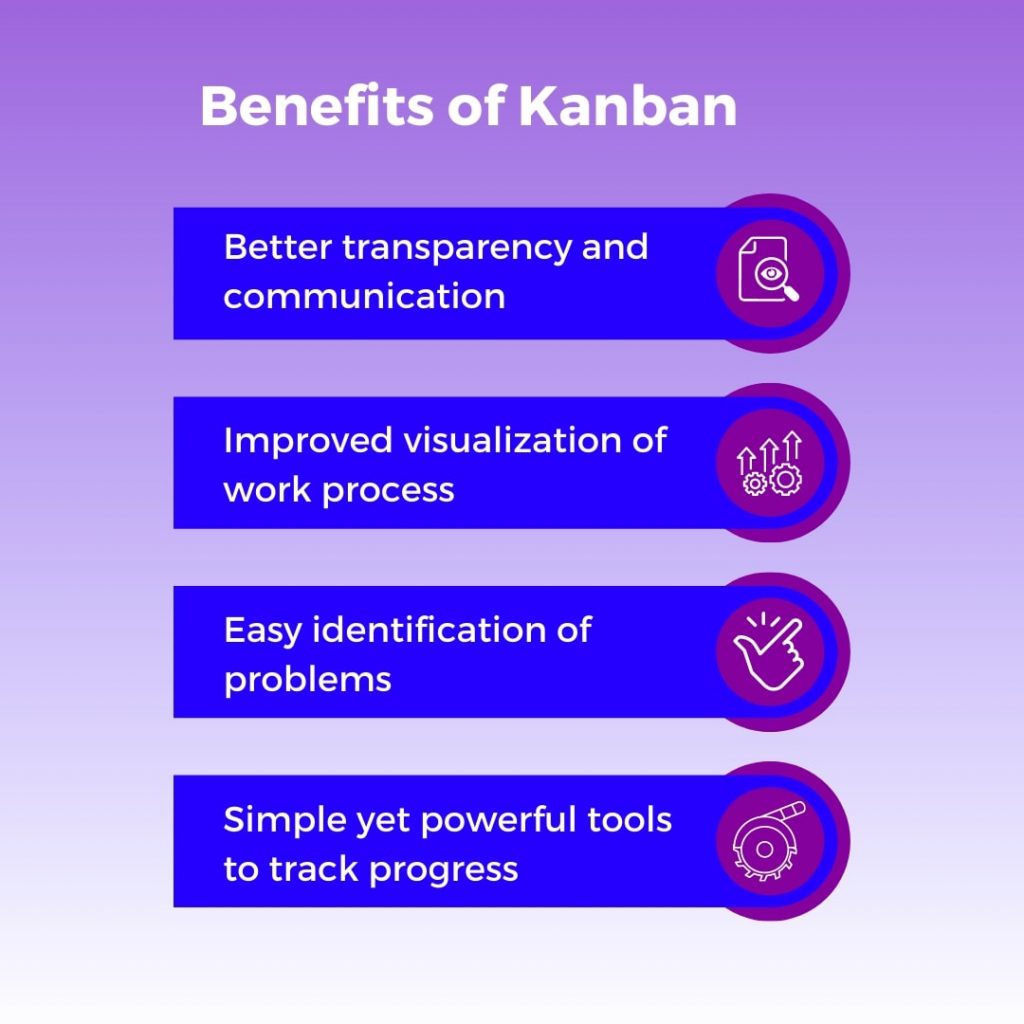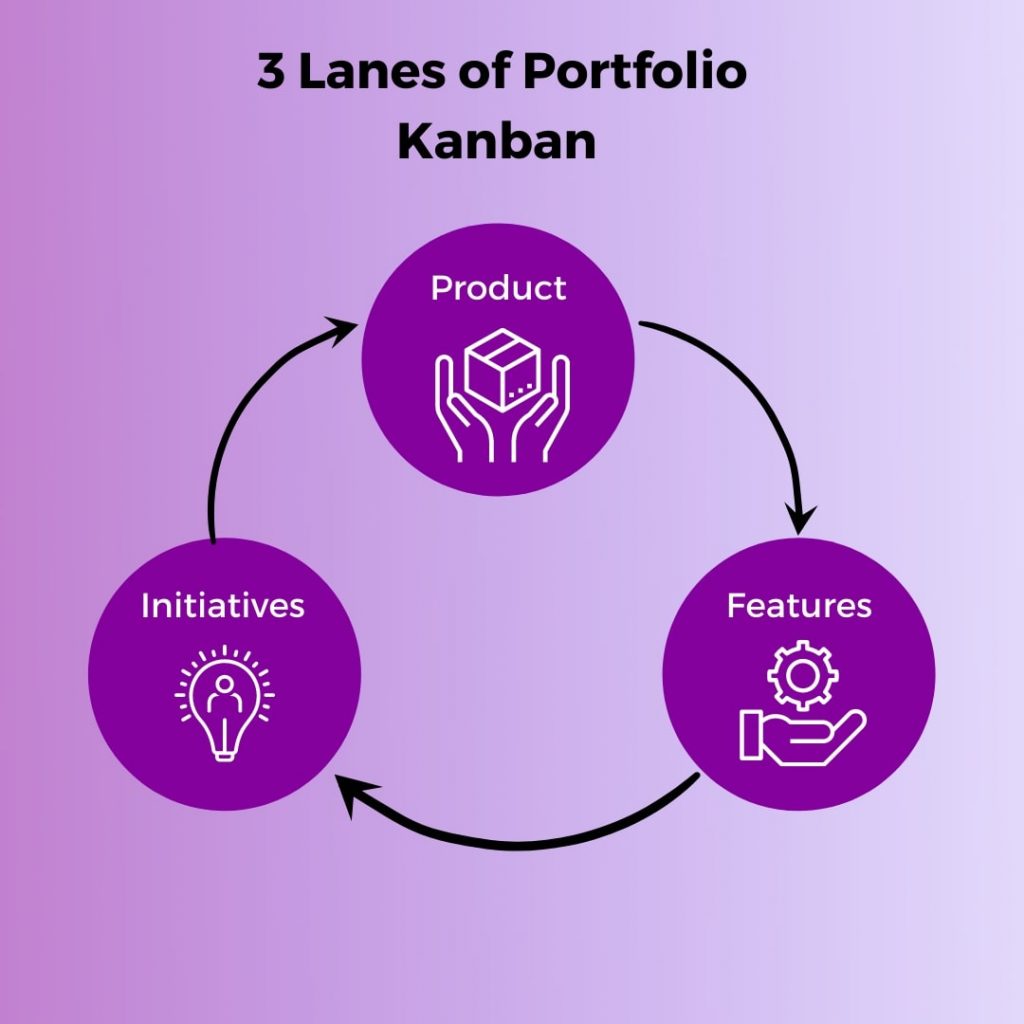What is Kanban and How You Can Implement it?

This article covers:
- What Is Kanban?
- How to Start Implementing Kanban in Three Easy Steps
- What Is Portfolio Kanban?
- Portfolio Management With Kanban
- Who Is Responsible for Managing the Portfolio Kanban?
- Responsibility for Implementing and Managing the Portfolio Kanban
- What Are the 6 Rules for the Application of Kanban?
- Conclusion
Kanban is a work management system that can help you visualize your work, limit work in progress, and maximize efficiency.
What Is Kanban?
Kanban is a framework that helps implement agile during software development.
It requires full transparency between team members and a realistic optimization of the tasks to maximize efficiency. This transparency comes through a visual representation and a productivity tool called the kanban board.
Advantages of Kanban
The core principle of Kanban is to promote time efficiency and task planning. Kanban is very flexible, and the changes outside the team do not hamper the work in progress.
Since it is continuous, product owners can prioritize tasks in kanban without disrupting the current work in progress. Kanban teams continuously deliver products to their customers.
Another benefit of the kanban framework is how it optimizes the cycle time so that teams can effectively predict the completion of tasks. Cycle time is a crucial metric for kanban teams because it measures the amount of time a single task takes in the workflow from start to finish.
Compared to scrum (another agile framework), kanban is flexible because it promotes changes and continuous delivery.
No roles (product owners, managers, and so on) get assigned to team members. Some teams combine the good parts of scrum and Kanban. This blend of the two is called Scrumban.

How to Start Implementing Kanban in Three Easy Steps
We’ve seen that kanban is a flexible model because it conveniently accommodates the team’s needs. Let’s look at how to start implementing kanban in a team.
The following are steps you can undertake to start implementing Kanban right away.
Step 1: Define the process.
We can define the process in kanban by creating a visual representation.
You can do it by creating cards that represent tasks. For example, we can create one card per task in our list and then put them on the board according to their status or priority.

The color-coded kanban board will show you which stages your work is currently at and what you need to do next.
You can ask questions such as how to schedule tasks, who assigns them, and their priority. Another good question is how to allocate them among team members based on skills or availability.
Because it is kanban, we do not need to “fix” the process. Keep it as fluid as possible.
When we talk about defining the process, it is also essential to evaluate the current workflow because it will help identify where we need change.
Change can be implemented in kanban when you understand whether your workflow is good or bad.
A good workflow in kanban means that everyone is working at the same pace. The work is continuous and without any delay.
A lousy workflow in kanban means that one person or group is doing all the work, and others are waiting for more tasks. There are a lot of stops and abrupt starts in a bad workflow.
It’s important to know which type of process you have so that you can make changes smoothly when you start implementing kanban.
Step 2: Measure the Work in Progress (WIP).
WIP is nothing but measuring how many tasks teams are working on at any given point. How much time an employee spends doing a task should be calculated, too, and how long it takes to finish a job.
Ensuring that the WIP is limited is essential to avoid multitasking and foster focus. To limit the WIP, it is necessary to set limits on tasks and the number of people working on a job at any given time.
It ensures more focus by reducing multitasking opportunities for employees. Team members can complete their tasks more efficiently to implement kanban successfully.
Reducing the WIP includes improved workflow, increased focus, and reduced multitasking opportunities.
Step 3: Assess and Update.
As mentioned in the first step, Kanban is not a fixed set of processes.
Since it is fluid, this last step involves welcoming change and constantly evolving. Modifying kanban is vital because tasks and priorities change as the work process changes.
Make sure you analyze your priorities by asking questions such as:
- What is your goal shortly?
- How do you know if you did the work well?
- How does it affect others in the team and organization?
It’s also essential to always have a backlog of tasks when priorities change. It means having an idea of what to prioritize next and what you should mostly work on.
Assess the team performance using kanban metrics such as lead time and cycle time to gain some actionable judgment. How team members feel about their work is also an important metric to track!
- How does the team feel about its work?
- How are you doing in meeting deadlines for tasks and projects?
- How is the team feeling at the end of a day’s worth of work?
These are all questions to ask when you implement Kanban.
Now that we know how to implement kanban, we need to investigate portfolio management with kanban, who manages it, and its responsibilities.
What Is Portfolio Kanban?
Portfolio kanban is a system for managing and improving workflow through a portfolio of projects. It provides a visual way to see the status of each project and the work that teams need to finish moving forward.
The key benefits of using portfolio kanban are improved visibility, reduced cycle time, and increased throughput. Individuals, teams, or organizations can use the system to manage any work, from product development to marketing campaigns.
Portfolio kanban is a way to visualize and manage your project portfolio. It helps you see what projects are in progress, what resources you need to complete them, and how they are related.
The portfolio Kanban board has three lanes:
- Products
- Initiatives
- Features

Few points to remember
- The product line contains high-level product ideas.
- The initiatives lane has specific initiatives that will deliver those products.
- The features lane contains the individual features provided as part of those initiatives.
The portfolio kanban method extends the original kanban method that helps organizations manage and optimize their product and technology portfolios.
It is a safe, scalable, and effective way to manage large product portfolios and ensure that critical projects don’t get delayed or lost in the shuffle.
The portfolio kanban system contains five components:
- The portfolio backlog
- The product backlog
- The product-level Kanban boards
- The feature-level Kanban boards
- Team-level Kanban boards.
With portfolio kanban, you can:
- Visualize your project portfolio
- See which projects are in progress and which ones are complete
- See that teams need what resources for the project and how they are related
- Quickly move projects between stages
- Track the progress of each project
Portfolio Management With Kanban
The epic owner runs portfolio management with Kanban.
Epics in kanban help represent features, tasks, and other portfolio items.
Managing portfolio items such as implementation and prioritization is essential in Kanban.
This portfolio management has three parts:
- Prioritizing portfolio items to understand where to put development efforts.
- Implementing the portfolio items to create tasks and estimate their completion with time and other resources needed. They also need to decide how or when to complete those portfolio items. It would help if you had dependency between each item where you should complete one item before moving to the next one.
- Managing portfolio items by determining what to do next or if any portfolio item is pending for some reason. It may require taking corrective steps like removing impediments that block progress.
Who Is Responsible for Managing the Portfolio Kanban?
Team members are not assigned any roles in kanban. As much as it is a shared responsibility, epic owners are primarily responsible for managing the portfolio kanban.
Remember that, in a scaled agile framework (SAFe), the role of an epic owner is ‘assumed’ by an individual rather than assigned as a job title. Epic owners only succeed when collaborating effectively with other team members and groups.
An epic owner guides the individual epic through the portfolio kanban system. Once the epics are down the portfolio kanban system, they are responsible for creating the lean business case.
Along with managing portfolio kanban, their other responsibilities involve defining the epic, formulating its minimum viable product, gaining approval, and finally implementing it.
They also support initiatives moving down the continuous delivery pipeline towards the release on demand.
There is no hard and fast rule that epic owners have to be the ones who manage the portfolio kanban.
One of the features of kanban is there is no role assignment.
The person responsible for managing the portfolio, kanban, is the person the team follows. This person depends on your organization’s policies and processes since there are many ways to set up portfolio management.
No matter who is responsible for managing the portfolio kanban, the responsibilities include:
- Prioritizing work in order of urgency or impact; deciding which deliverables will go up next; delegating those tasks, and so on.
- Managing a timeline for the team, communicating priorities, and ensuring enough capacity to meet deadlines.
- Check if kanban cards get completed correctly to ensure they’re not blocking anything else.
- Identifying potential risks or issues with implementing requirements and features; determining if the available resources for each project are feasible or not.
- Developing work plans and timelines for teams that include dependencies wherever necessary.

- Facilitating discussions about progress on key initiatives at management meetings.
Responsibility for Implementing and Managing the Portfolio Kanban
As mentioned above, the responsibility for implementing and managing the portfolio kanban lies on the epic owner.
This responsibility is crucial because it gives the team a clear understanding of managing and maintaining their portfolio items.
It also helps them emphasize prioritizing important work over less urgent tasks.
This responsibility for implementing and managing the portfolio kanban can be challenging when the portfolio is large and complex.
For some reason, the epic owner needs to figure out how to deal with portfolio items that are not relevant, outdated, or problematic.
In this case, it may require delegating tasks, which could mean assigning them to another team member or outsourcing work outside the company.
What Are the 6 Rules for the Application of Kanban?
Kanban is a visual management tool that helps teams limit work in progress (WIP) and track the flow of tasks. The theory behind kanban is that teams can optimize their productivity by limiting WIP and monitoring the flow of tasks.
Bonus: Tap here to know all about product vision.
Companies use it for product management tools, process improvement, and software development. It helps you manage your work by optimizing the workflow and limiting work progress.
Kanban has six rules that help to optimize the flow of work.
There are six basic rules for the application of Kanban:
- Visualize your work
- Limit your work in progress
- Define your workflow
- Use kanban boards to track your tasks
- Implement feedback loops
- Continuous improvement
What Is Portfolio Kanban in SAFe?
Kanban is one of the most popular and successful agile product management methods for software development. Nowadays, you can find it popularly incorporated into product manager tools.
The portfolio kanban system in Scaled Agile Framework (SAFe) is a system that helps you visualize and manage the flow of value through your system.
It is one of the essential tools to ensure that your system delivers value to your stakeholders. It helps identify and prioritize opportunities, dependencies, and risks.
The portfolio kanban system is a tool used in the Scaled Agile Framework (SAFe) to help organizations manage their portfolios of products and services. The basis of the system is the kanban principle of “pulling” work from a queue, which helps to ensure that teams work on only the most crucial tasks at any given time.
Portfolio kanban is a lean and agile method for managing a portfolio of projects or products.
The basis is the kanban method for project management, which comes from the Toyota Production System.
The Main Benefits of Using Portfolio Kanban in SAFe Are that It Can Help You:
- Visualize your entire portfolio in a single view
- Prioritize and manage your work more effectively.
- Make better decisions about what to work on next.
Conclusion
Now that you know how to implement kanban in your organization, it’s time to use product management software that helps you implement it efficiently.
Try Chisel to prioritize features and builds, get team alignment, and put them on your kanban board.
